Artificial Radionuclides in the System: Water, Irrigated Soils, and Agricultural Plants of the Crimea Region
(This article belongs to the Section Land, Soil and Water)
Abstract
:1. Introduction
2. Materials and Methods
2.1. Sampling Site and Materials
- -
- 205 water samples (including 133 samples for the determination of 90Sr, 48 samples for determination of 137Cs, 24 samples for determination of transuranium elements);
- -
- 45 samples of suspended matter (including 5 samples for the determination of 90Sr, 24 samples for the determination of 137Cs, 16 samples for determination of transuranium elements);
- -
- 96 samples of bottom sediments (including 24 samples for the determination of 90Sr, 48 samples for the determination of 137Cs, 24 samples for determination of transuranium elements);
- -
- 100 samples of irrigated soils (including 26 samples for the determination of 90Sr, 48 samples for the determination of 137Cs, 26 samples for determination of transuranium elements);
- -
- 60 samples of cultivated crops (including 21 samples for the determination of 90Sr, 21 samples for the determination of 137Cs, 18 samples for determination of transuranium elements).
2.2. Methods
2.2.1. 137Cs Procedures
2.2.2. 90Sr Radiochemical Procedures
2.2.3. 238,239+240Pu and 241Am Radiochemical Procedures
2.2.4. Determination of Quantitative Characteristics (Coefficients)
3. Results
3.1. 90Sr in the NCC Ecosystem–Irrigated Soils–Cultivated Plants
3.2. 137Cs and Radionuclides of Transuranium Elements in the NCC Irrigation System
4. Discussion
4.1. 90Sr in the NCC Ecosystem–Irrigated Soils–Cultivated Plants
4.2. 137Cs and Transuranium Elements in the NCC Irrigation System
5. Conclusions
Author Contributions
Funding
Data Availability Statement
Acknowledgments
Conflicts of Interest
References
- Aarkrog, A. Source terms and inventories of anthropogenic radionuclides. In Radioecology. Lectures in Environmental Radioactivity; Holm, E., Ed.; World Scientific Publishing: Lund, Sweden, 1994; pp. 21–38. [Google Scholar]
- Beresford, N.; Fesenko, S.; Konoplev, A.; Skuterud, L.; Smith, J.T.; Voigt, G. Thirty years after the Chernobyl accident: What lessons have we learnt? J. Environ. Radioact. 2016, 157, 77–89. [Google Scholar] [CrossRef] [PubMed]
- Talerko, M.; Garger, E.; Lev, T.; Nosovskyi, A. Atmospheric Transport of Radionuclides Initially Released as a Result of the Chernobyl Accident. In Behavior of Radionuclides in the Environment II Chernobyl: Chernobyl; Konoplev, A., Kato, K., Kalmykov, S.N., Eds.; Springer Nature Singapore Pte Ltd.: Singapore, 2020; Chapter I; pp. 3–75. [Google Scholar]
- Polikarpov, G.G.; Egorov, V.N.; Gulin, S.B.; Stokozov, N.A.; Lazorenko, G.E.; Mirzoyeva, N.Y.; Tereschenko, N.N.; Tsitsugina, V.G.; Kulebakina, L.G.; Popovichev, V.N.; et al. Radioecological Response of the Black Sea to the Chernobyl Accident; EKOSI-Gidrofizika: Sevastopol, Russia, 2008; 667p. (In Russian) [Google Scholar]
- Tereshchenko, N.N.; Mirzoyeva, N.Y.; Gulin, S.B.; Milchakova, N.A. Contemporary radioecological state of the North-western Black Sea and the problems ofenvironment conservation. Mar. Pollut. Bull. 2014, 81, 7–23. [Google Scholar] [CrossRef] [PubMed]
- Egorov, V.N.; Povinec, P.P.; Polikarpov, G.G.; Stokozov, N.A.; Gulin, S.; Kulebakina, L.G.; Osvath, I. 90Sr and 137Cs in the Black Sea after the Chernobyl NPP accident: Inventories, balance and tracer applications. J. Environ. Radioact. 1999, 43, 137–156. [Google Scholar] [CrossRef]
- Mirzoeva, N.Y.; Egorov, V.N.; Gulin, S.B. Radionuclides 137Cs and 90Sr in Components of the Black Sea Ecosystems: Contemporary Status and Prognosis. In Diversity in the Coastal Marine Sciences: Historical Perspectives and Contemporary Research of Geology, Physics, Chemistry, Biology and Remote Sensing; Coastal Research Library; Finkl, C.W., Makowski, C., Eds.; Springer: Dordrecht, The Netherlands, 2018; Chapter 17; Volume 23, pp. 275–294. [Google Scholar] [CrossRef]
- Gulin, S.B.; Mirzoyeva, N.Y.; Egorov, V.N.; Polikarpov, G.G.; Sidorov, I.G.; Proskurnin, V.Y. Secondary radioactive contamination of the Black Sea after Chernobyl accident: Recent levels, pathways and trends. J. Environ. Radioact. 2013, 124, 50–56. [Google Scholar] [CrossRef] [PubMed]
- Gulin, S.B.; Mirzoeva, N.Y.; Lazorenko, G.E.; Egorov, V.N.; Trapeznikov, A.V.; Sidorov, I.G.; Proskurnin, V.Y.; Popovichev, V.N.; Bey, O.N.; Rodina, E.A. Modern radiological situation associated with the mode of operation of the North Crimean Canal. Radiatsionnaya Biologiya. Radioekol. 2016, 56, 647–654. (In Russian) [Google Scholar] [CrossRef]
- Program, Law of Ukraine dated 15.01.2009 No. 886-VI, “On the National Program for the Decommissioning of the Chernobyl Nuclear Power Plant and the Transformation of the Shelter Object into an Environmentally Safe System.” dated 16 October 2018 N 2595-VIII). Available online: https://ips.ligazakon.net/document/TO90886 (accessed on 22 July 2022). (In Ukrainian).
- Sokolov, A.A. Hydrography of the USSR (Land Waters); Gidrometeoizdat: Leningrad, Russia, 1964; 535p. (In Russian) [Google Scholar]
- Denisova, A.I.; Timchenko, V.M.; Nakhshina, E.P.; Novikov, B.I.; Ryabov, A.K.; Bass, Y.I. Hydrology and Hydrochemistry of the Dnieper and Its Reservoirs; Naukova Dumka: Kyiv, Ukraine, 1989; 216p. (In Russian) [Google Scholar]
- Grese, V.N.; Polikarpov, G.G.; Romanenko, V.D. Nature of the Ukrainian SSR. In Seas and Inland Waters; Romanenko, V.D., Ed.; Naukova Dumka: Kyiv, Ukraine, 1987; 224p. (In Russian) [Google Scholar]
- Kulebakina, L.G. Migration of radionuclides from the Chernobyl zone to the ameliorative systems of the south of Ukraine. In Proceedings of the National Conference “Radioecological and Economic and Legal Aspects of Land Use after the Accident at the Chernobyl Nuclear Power Plant”, Kyiv, Ukraine, 27–30 March 1991. (In Russian). [Google Scholar]
- Polikarpov, G.G.; Lazorenko, G.E. Detected radionuclides on the soil of Ukraine (Spain Ukrainian–Italian Expedition). Bull. Natl. Acad. Sci. Ukr. 1992, 2, 94–95. (In Ukrainian) [Google Scholar]
- Polikarpov, G.G.; Lazorenko, G.E.; Korotkov, A.A.; Mirzoeva, N.Y. The role of suspended matter and bottom sediments of the aquatic ecosystem of the Northern Crimean Canal in the migration of 90Sr, 137Cs, 238Pu and 239+240Pu. Rep. Natl. Acad. Sci. Ukr. 1995, 7, 135–139. (In Russian) [Google Scholar]
- Korotkov, A.A. Deposition of transuranics in biotic and abiotic components of water bodies near the Chernobyl NPP, the Kakhovskoe reservoir and the North Crimean Canal. In Proceedings of the international seminar “Radioecology: Successes and prospects”, Sevastopol, Ukraine, 3–7 October 1994. (In Russian). [Google Scholar]
- Lazorenko, G.E. Distribution patterns of 137Cs of the Chernobyl origin in the irrigation zone of the North Crimean Canal. In Proceedings of the Conference “Natural and Nuclear Anomalies and Life Safety”, Vilnius, Lithuania, 25–26 September 1998. (In Russian). [Google Scholar]
- Tereshchenko, N.N. Study of Pu and Am in bottom sediments of near-bottom and anthropogenic water systems and soils adjacent to them in the near zone of the Chernobyl NPP and in the south of Ukraine. Hyg. Popul. Places 2000, 36 Pt 1, 414–419. (In Russian) [Google Scholar]
- Egorov, V.N.; Polikarpov, G.G.; Lazorenko, G.E.; Mirzoeva, N.Y.; Korotkov, A.A. Radioecological studies of the Crimean region after the accident at the Chernobyl nuclear power plant. In Topical Issues of the Development of Innovative Activities in States with Economies in Transition; SONAT: Simferopol, Ukraine, 2001; pp. 59–63. (In Russian) [Google Scholar]
- Polikarpov, G.G.; Lazorenko, G.E.; Tereshchenko, N.N.; Mirzoyeva, N.Y. The North Crimean Canal as a model object of radioecological study the transport of the Chernobyl radionuclides to the Black Sea. Mar. Hydrophys. J. 2015, 3, 27–36. [Google Scholar]
- Mirzoyeva, N.Y.; Arkhipova, S.I.; Kravchenko, N.V. Sources of inflow and nature of redistribution of 90Sr in the salt lakes of the Crimea. J. Environ. Radioact. 2018, 188, 38–46. [Google Scholar] [CrossRef] [PubMed]
- Mirzoeva, N.; Shadrin, N.; Arkhipova, S.; Miroshnichenko, O.; Kravchenko, N.; Anufriieva, E. Does salinity affect the distribution of the artificial radionuclides 90Sr and 137Cs in water of the saline lakes? A case of the Crimean Peninsula. Water 2020, 12, 349. [Google Scholar] [CrossRef]
- Bey, O.N.; Proscurnin, V.Y.; Gulin, S.B. Measurement of the Cs concentration from its own β-radiation using liquid scintillation spectrometry. Radiochemistry 2016, 58, 147–149. [Google Scholar] [CrossRef]
- Harvey, B.R.; Ibbett, R.D.; Lovett, M.B.; Williams, K.J. Analytical procedures for the determination of strontium radionuclides in environmental materials. In Aquatic Environment Protection: Analytical Methods; Ministry of Agriculture Fisheries and Food, Directorate of Fisheries Research: Lowestoft, UK, 1989; Volume 5, pp. 1–33. [Google Scholar]
- IAEA. Measurement of Radionuclides in Food and the Environment. Technical Report Series № 295; IAEA: Vienna, Austria, 1989; 182p. [Google Scholar]
- Tereshchenko, N.N.; Gulin, S.B.; Proskurnin, V.Y. Distributionand migration of 239+240Pu in abiotic components of the Black Sea ecosystems during the post-Chernobyl period. J. Environ. Radioact. 2018, 188, 67–78. [Google Scholar] [CrossRef] [PubMed]
- Tereshchenko, N.N.; Proskurnin, V.Y.; Paraskiv, A.A.; Chuzhikova-Proskurnina, O.D. Man-made plutonium radioisotopes in the salt lakes of the Crimean peninsula. J. Oceanol. Limnol. 2018, 36, 1917–1929. [Google Scholar] [CrossRef]
- Miroshnichenko, O.N.; Mirzoeva, N.Y.; Sidorov, I.G. 137Cs in abiotic components of ecosystems of the Crimean salt lakes: Sources of inflow, features of distribution and elimination. Fundam. Appl. Limnol. 2022, 195, 275–295. [Google Scholar] [CrossRef]
- Konoplev, A.; Kenji, K.; Kalmykov, S.N. (Eds.) Behavior of Radionuclides in the Environment II Chernobyl; Springer Nature Singapore Pte Ltd.: Singapore, 2020; 447p. [Google Scholar]
- Kuzmenko, M.I.; Volkova, E.N.; Klenus, V.G. Spatio-temporal distribution of radionuclides and their impact on the biosystems of the Dnieper and its reservoirs. In Proceedings of the International Seminar “Radioecology: Successes and Prospects”, Sevastopol, Ukraine, 3-7 October 1994. [Google Scholar]
- Database of the RChBD IBSS (for the period 1964–2006): Water. Hydrobionts. Bottom sediments [Electronic resource], was developed in RChBD, IBSS, Sevastopol. 1992.
- Voitsekhovitch, O.V.; Shestopalov, V.M.; Skalskiy, A.S. Monitoring of Radioactive Contamination of Surface and Ground Waters after the Chernobyl NPP Accident; Series “Radiation and Water”; Ukrainian Research Hydrometeorologica Institute: Kiev, Ukraine; Institute of Geological Sciences NAS of Ukraine: Kiev, Ukraine; 148p. (In Russian)
- RSS-99/2009. Radiation Safety Standards (NRB-99/2009): The Sanitary Rules and Regulations (SanR& R2.6.1.2523–09): Approved. and Enter. in Force From 1 September 2009 to Replace SanR& R 2.6.1.758-99. Registered with the Ministry of Justice 14 August 2009, Reg. Number 14534. Available online: http://base.garant.ru/4188851/#1000 (accessed on 31 July 2022). (In Russian).
- Mirzoyeva, N.Y.; Egorov, V.N.; Polikarpov, G.G. Distribution and migration of 90Sr in components of the Dnieper river basin and the Black Sea ecosystems after the Chernobyl NPP accident. J. Environ. Radioact. 2013, 125, 27–35. [Google Scholar] [CrossRef] [PubMed]
- Methodological Guidelines 2.6.1.1194-03 Ionizing Radiation, Radiation Safety, Radiation Control. Strontium-90 and Cesium-137. Food Products. Sample Selection, Analysis and Hygienic Assessment; Ministry of Health of Russia: Moscow, Russia, 2003; 31p, Available online: https://ohranatruda.ru/upload/iblock/05f/4293853289.pdf (accessed on 26 July 2022).
- Perepelyatnikov, G.P. Assessment of the radiation situation on irrigated lands. Rep. Natl. Acad. Sci. Ukr. 1994, 1, 152–154. (In Russian) [Google Scholar]
- Risik, N.S.; Polikarpov, G.G.; Kulebakina, L.G.; Egorov, V.N.; Gulin, S.B. Radioactive contamination of the Crimea after the Chernobyl accident. In Proceedings of the International Seminar “Radioecology: Successes and prospects”, Sevastopol, Ukraine, 3–7 October 1994. (In Russian). [Google Scholar]
- Romanenko, V.D.; Volkova, E.N.; Kuzmenko, M.I.; Pankov, I.V. Radionuclides in the biosystems of the Dnieper reservoirs. Rep. Natl. Acad. Sci. Ukr. 1994, 1, 154–157. (In Russian) [Google Scholar]
- Kuznetsov, A.K.; Sanzharova, N.I.; Perepelyatnikov, G.P.; Malikov, V.G.; Aleksakhin, R.M. Receipt of artificial radionuclides in vegetable crops from the soil during sprinkler irrigation. Agrochemistry 1990, 7, 96–99. (In Russian) [Google Scholar]
- Aleksakhin, R.M.; Energoatomizdat, M. (Eds.) Radioecology of Irrigated Agriculture; En-ergoatomizdat: Leningrad, Russia, 1985; 225p. (In Russian) [Google Scholar]
- Aleksakhin, R.M. (Ed.) Agricultural Radioecology; Nauka: Moscow, Russia, 1993; 538p. (In Russian) [Google Scholar]

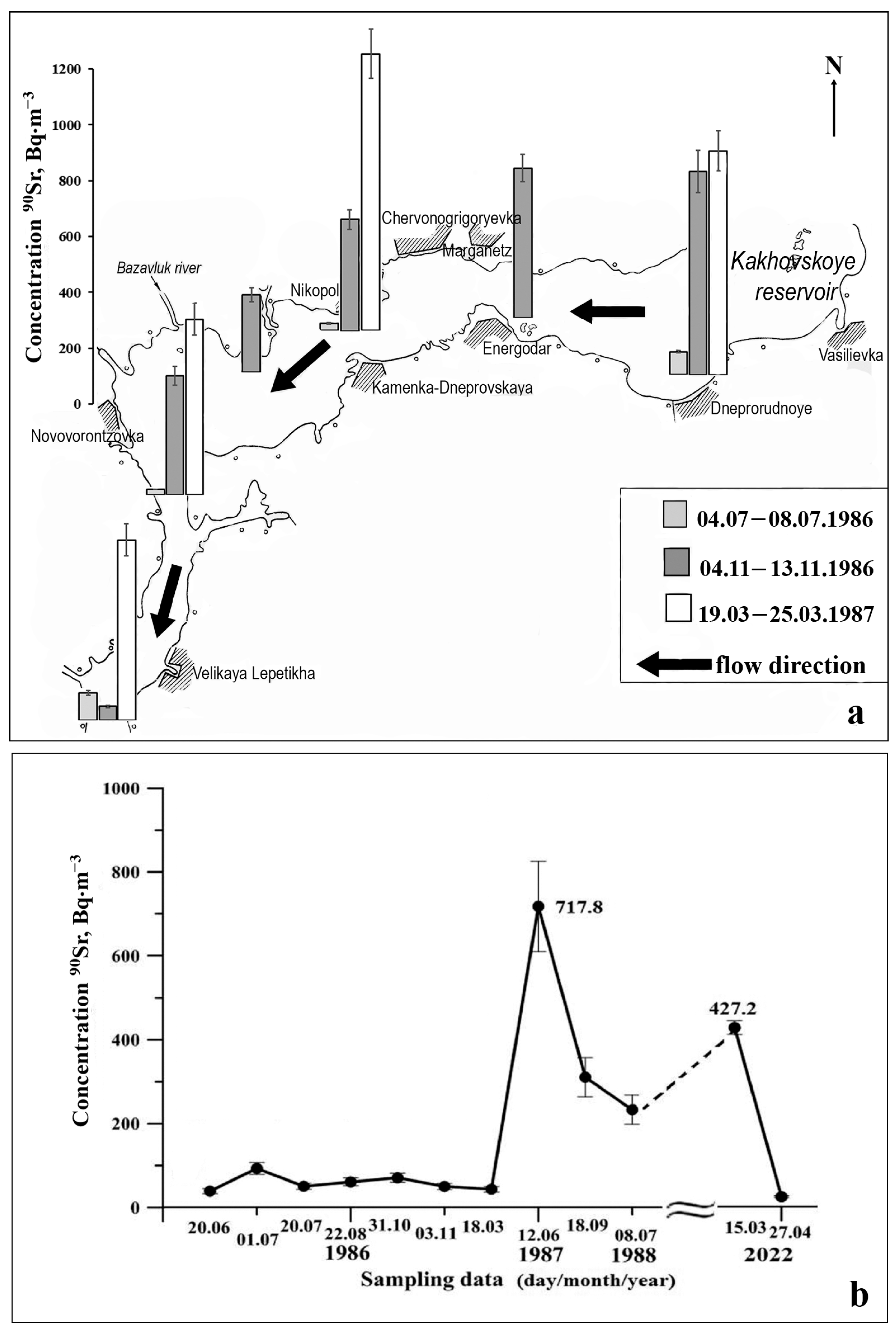
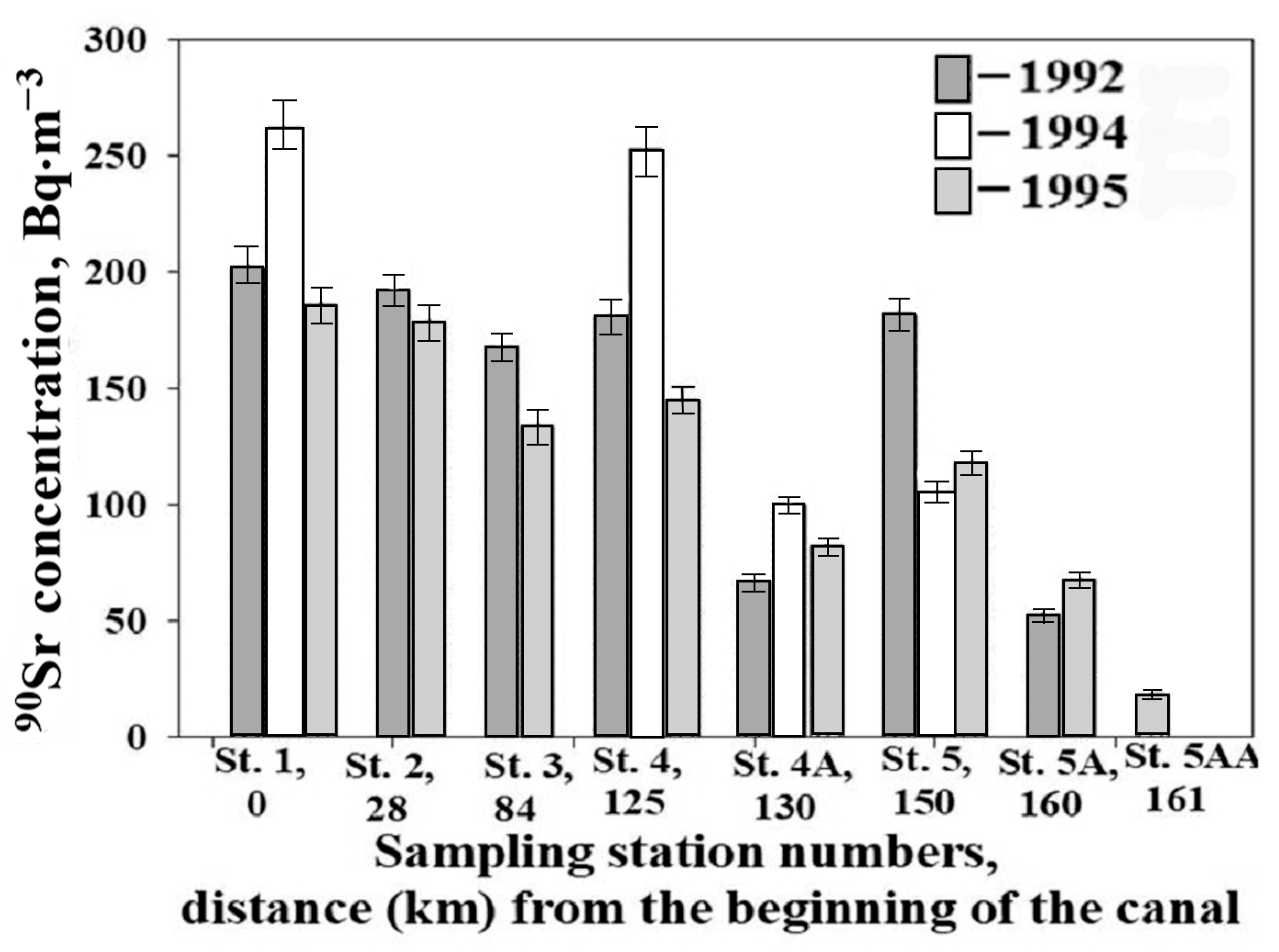
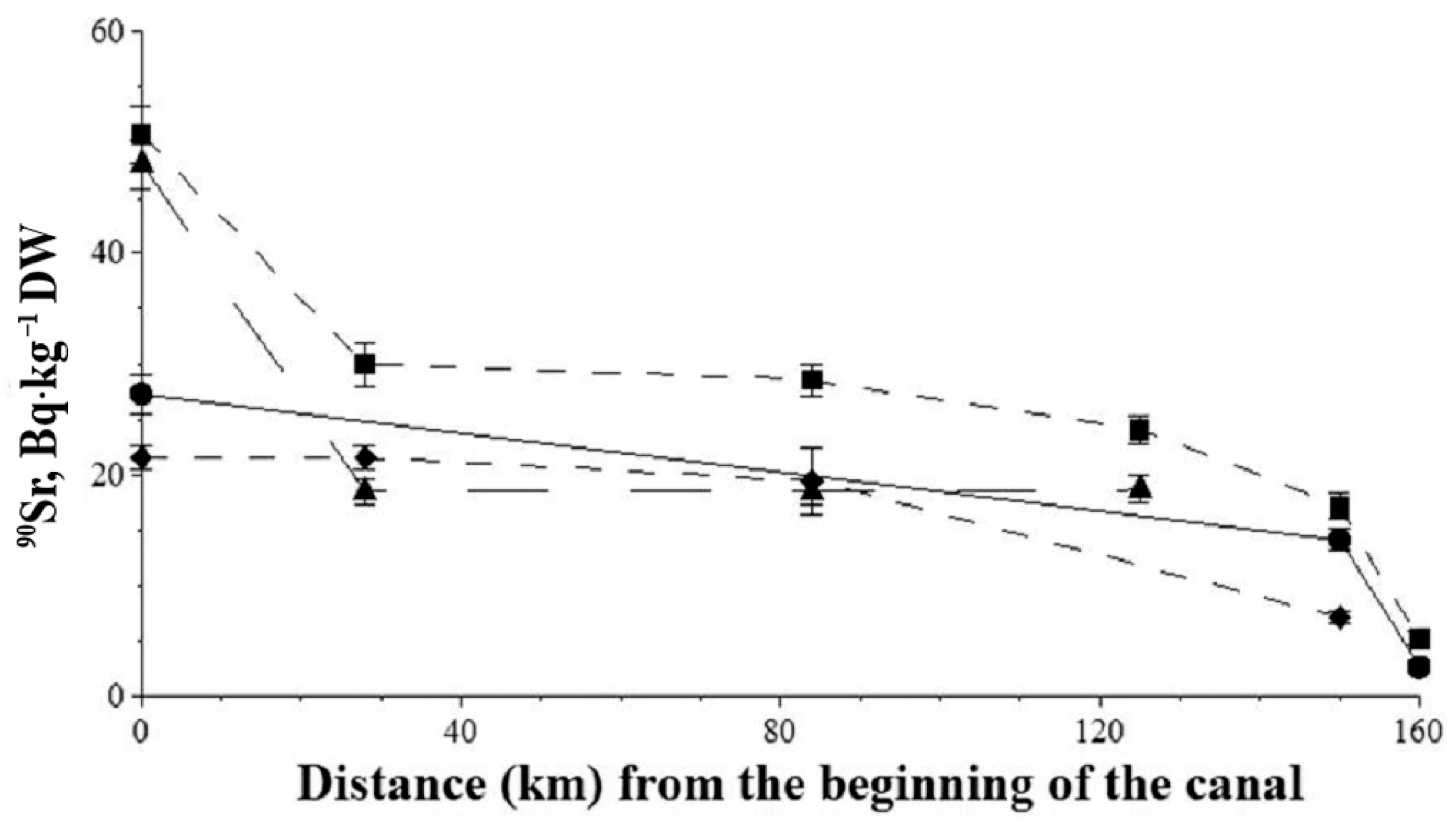

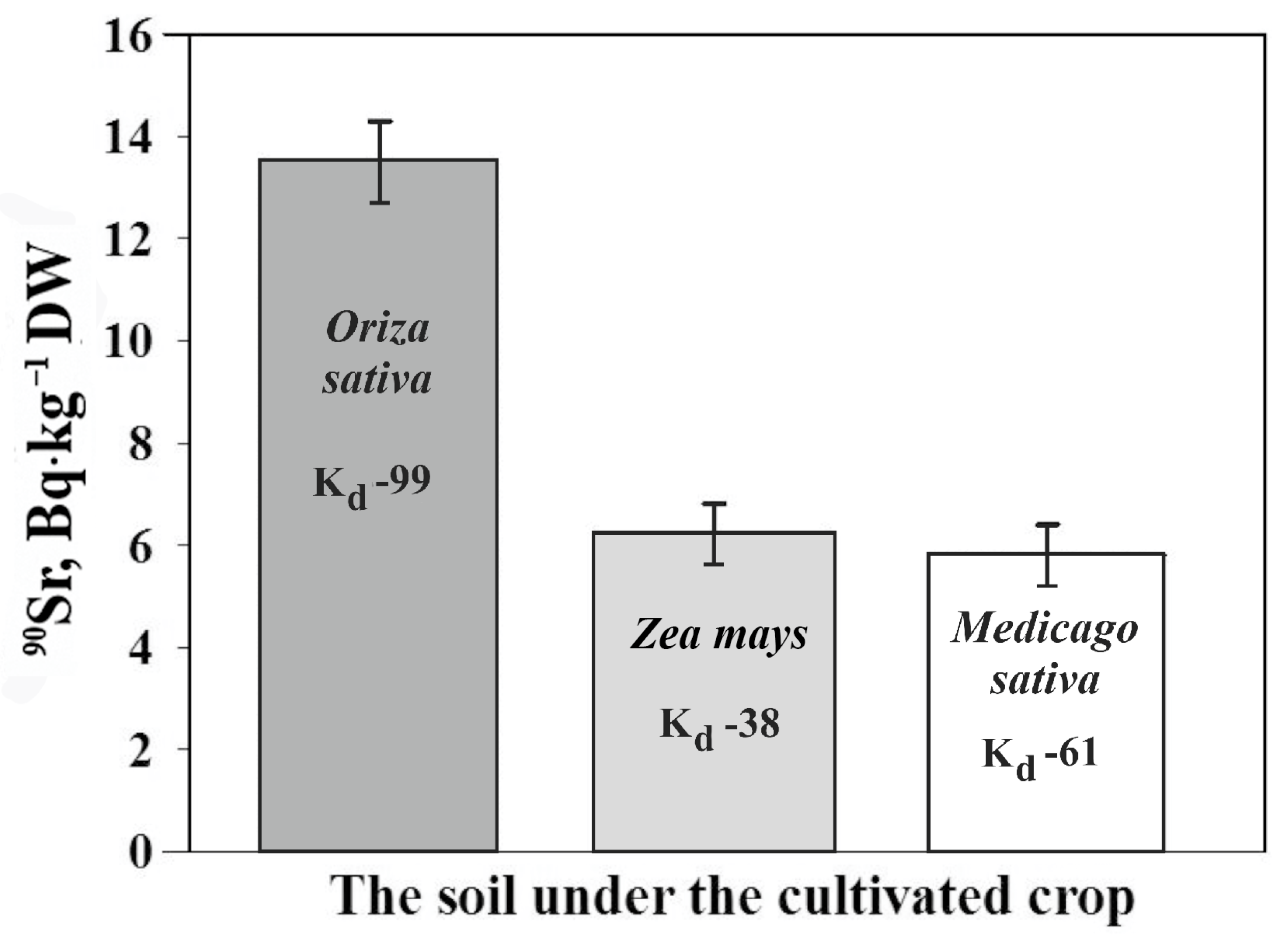




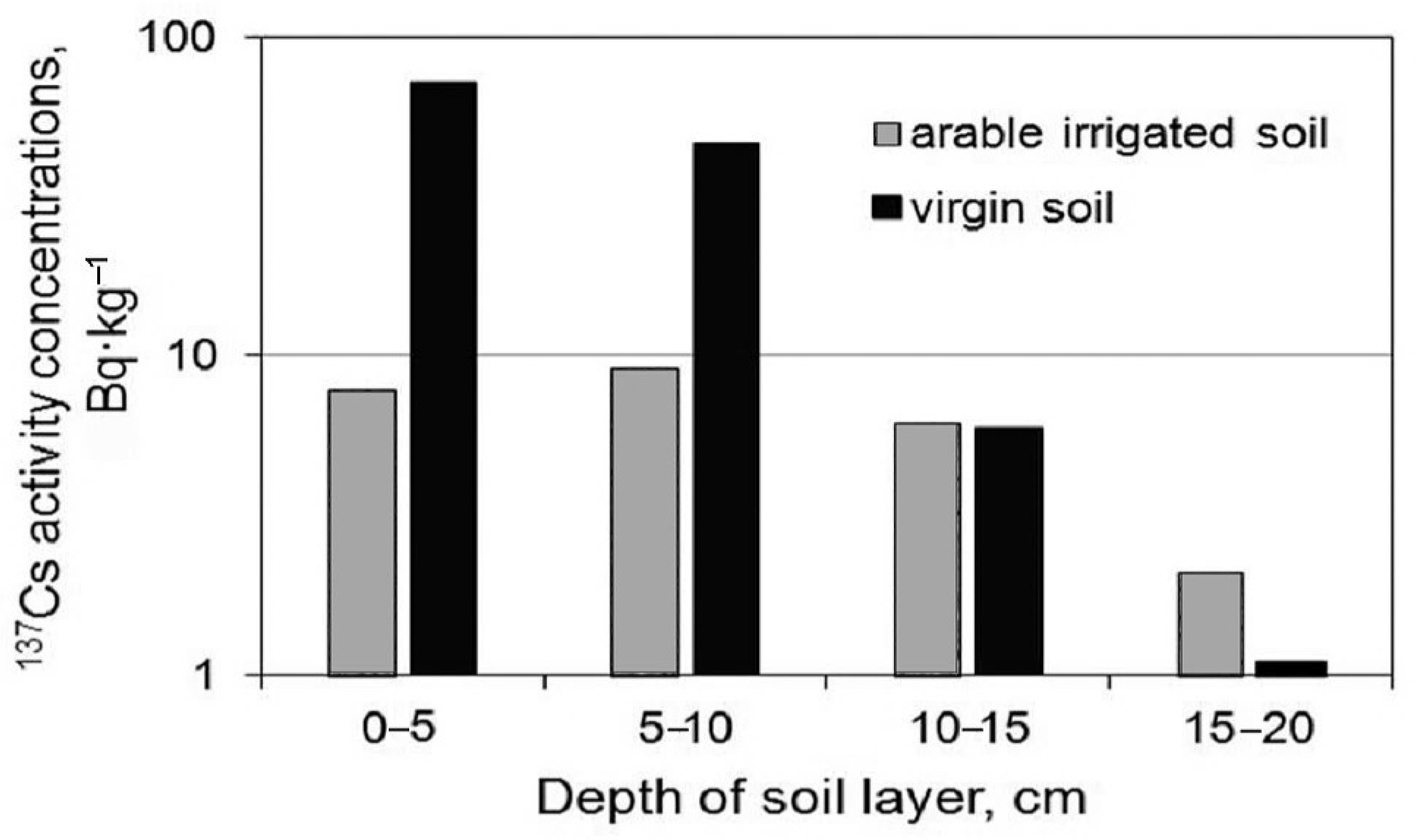
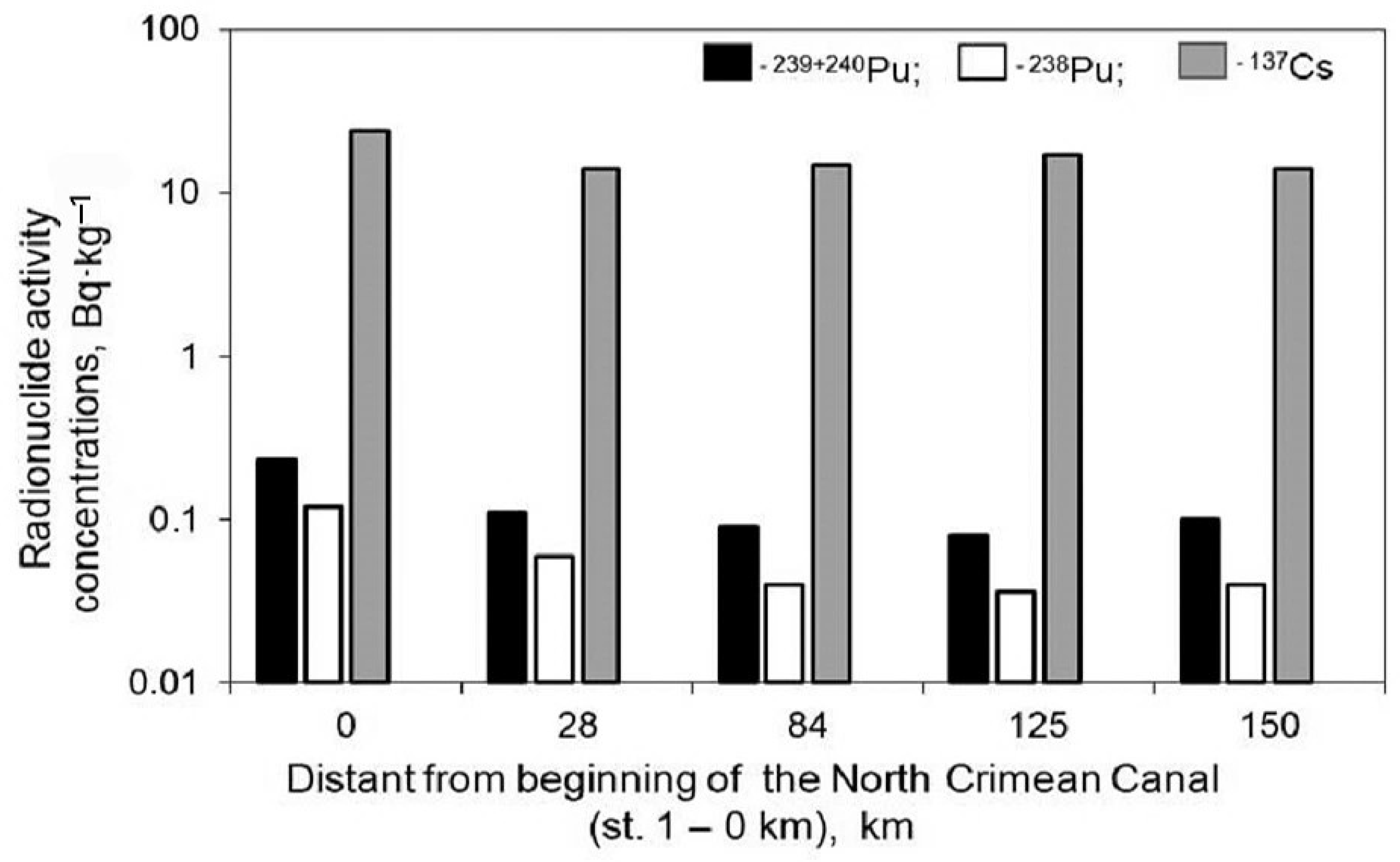

| Year | NCC Water Volume for Irrigation, Million m3 | C, 90Sr, Bq·m−3 | Quantity Measurements/ (References) | Total Activity Brought with Water, GBq |
|---|---|---|---|---|
| 1986 | 2831.3 | 59.3 | 38 | 167.9 |
| 1987 | 2464.9 | 522.2 | 31 | 1287.2 |
| 1988 | 2480.0 | 296.0 | 30 | 734.1 |
| 1989 | 2585.4 | 258.5 | 7 | 668.4 |
| 1990 | 2961.8 | 205.0 | 1 | 607.2 |
| 1992 | 2842.7 | 199.0 | 1 | 565.7 |
| 1993 | 2842.7 | 155.0 | 8 | 440.6 |
| 1994 | 2842.7 | 282.1 | 5 | 801.9 |
| 1995 | 2842.7 | 105.6 | 12 | 300.2 |
| 1999 | 2003.2 | 147.5 | [33] | 309.1 |
| Entry result: | 5882.3 | |||
| Soil | № Station | Year | Layer, cm | C, 90Sr, Bq·kg−1 ± σ, Dry Weight | Kd |
|---|---|---|---|---|---|
| Flooded soilunder rice | 3 | 1993 | 0–10 | 13.7 ± 0.9 | 91 |
| 4 | 1992 | 0–10 | 7.5 ± 0.7 | 41 | |
| 1994 | 0–10 | 18.6 ± 0.9 | 74 | ||
| 1995 | 0–10 | 19.1 ± 1.4 | 132 | ||
| 5 | 1993 | 0–10 | 12.2 ± 0.3 | 67 | |
| 1994 | 0–10 | 11.2 ± 0.7 | 107 | ||
| 5A | 1995 | 0–10 | 12.2 ± 0.8 | 180 | |
| Soil under alfalfa | 2 | 1992 | 0–10 | 5.9 ± 0.7 | 31 |
| 1993 | 0–5 | 5.6 ± 0.5 | 178 | ||
| 1994 | 0–5 | 7.5 ± 0.7 | 40 | ||
| 1995 | 0–10 | 7.3 ± 0.8 | 41 | ||
| 3 | 1992 | 0–5 | 4.4 ± 0.7 | 26 | |
| 1993 | 0–5 | 2.5 ± 0.5 | 17 | ||
| 4A | 1994 | 0–10 | 4.1 ± 0.5 | 41 | |
| 1995 | 0–10 | 9.2 ± 0.3 | 112 | ||
| Soil under corn | 2 | 1995 | 0–5 | 7.3 ± 0.8 | 41 |
| 4 | 1994 | 0–5 | 6.3 ± 0.6 | 25 | |
| 5 | 1994 | 0–5 | 5.1 ± 0.5 | 48 |
| Plant Characteristic | № Station | Year | C,90Sr, Bq·kg−1 ± σ, Dry Weight |
|---|---|---|---|
| Medicago sativa (alfalfa) | |||
| Flowering plant | 2 | 1992 | 6.3 ± 0.4 |
| Shoots 3–4 cm | 1993 | 1.5 ± 0.2 | |
| Flowering plant | 1994 | 5.3 ± 0.3 | |
| Flowering plant | 4A | 1994 | 9.4 ± 0.6 |
| 5 | 1994 | 7.7 ± 0.5 | |
| 5A | 1994 | 8.1 ± 0.6 | |
| Triticum durum (wheat) | |||
| Stems with spikelets | 2 | 1992 | 1.5 ± 0.3 |
| Zea mays (corn) | |||
| Stems, leaves | 2 | 1992 | 1.9 ± 0.2 |
| 3 | 1992 | 0.8 ± 0.2 | |
| 4 | 1992 | 1.7 ± 0.3 | |
| 1994 | 1.9 ± 0.3 | ||
| 5 | 1994 | 2.8 ± 0.3 | |
| 5A | 1992 | 2.7 ± 0.3 | |
| Oriza sativa (rice) | |||
| Whole plant | 4 | 1992 | 5.5 ± 0.3 |
| 1994 | 4.3 ± 0.3 | ||
| Straw | 5 | 1992 | 2.1 ± 0.3 |
| Stems with grain | 1993 | 0.7 ± 0.2 | |
| Straw | 1994 | 2.2 ± 0.2 | |
| Stems with grain | 4A | 1993 | 1.5 ± 0.2 |
| Straw | 1993 | 1.4 ± 0.2 | |
| Straw | 5A | 1993 | 1.4 ± 0.2 |
| Station | Plant Name | TF, m2·kg−1 |
|---|---|---|
| № 2, 28 km of the NCC | alfalfa (green mass) | 1.3 × 10−2 |
| corn (stems, leaves) | 3.7 × 10−3 | |
| wheat (straw) | 3.0 × 10−3 | |
| № 3, 84 km of the NCC | corn (stems, leaves) | 4.9 × 10−3 |
| № 4, 125 km of the NCC | corn (stems, leaves) | 4.3 × 10−3 |
| rice (green mass) | 7.5 × 10−3 | |
| № 5, 150 km of the NCC | corn (stems, leaves) | 3.8 × 10−3 |
| alfalfa (green mass) | 2.1 × 10−2 |
Publisher’s Note: MDPI stays neutral with regard to jurisdictional claims in published maps and institutional affiliations. |
© 2022 by the authors. Licensee MDPI, Basel, Switzerland. This article is an open access article distributed under the terms and conditions of the Creative Commons Attribution (CC BY) license (https://creativecommons.org/licenses/by/4.0/).
Share and Cite
Mirzoeva, N.; Tereshchenko, N.; Korotkov, A. Artificial Radionuclides in the System: Water, Irrigated Soils, and Agricultural Plants of the Crimea Region. Land 2022, 11, 1539. https://doi.org/10.3390/land11091539
Mirzoeva N, Tereshchenko N, Korotkov A. Artificial Radionuclides in the System: Water, Irrigated Soils, and Agricultural Plants of the Crimea Region. Land. 2022; 11(9):1539. https://doi.org/10.3390/land11091539
Chicago/Turabian StyleMirzoeva, Natalia, Nataliya Tereshchenko, and Andrey Korotkov. 2022. "Artificial Radionuclides in the System: Water, Irrigated Soils, and Agricultural Plants of the Crimea Region" Land 11, no. 9: 1539. https://doi.org/10.3390/land11091539
APA StyleMirzoeva, N., Tereshchenko, N., & Korotkov, A. (2022). Artificial Radionuclides in the System: Water, Irrigated Soils, and Agricultural Plants of the Crimea Region. Land, 11(9), 1539. https://doi.org/10.3390/land11091539







